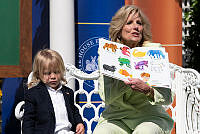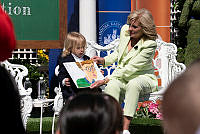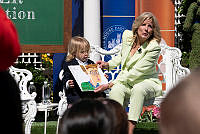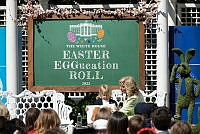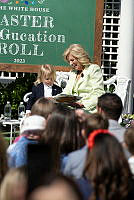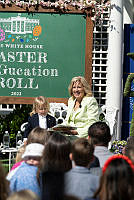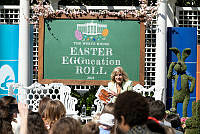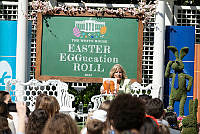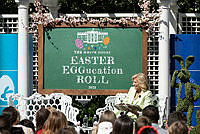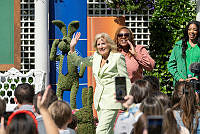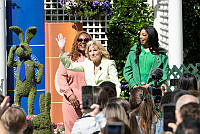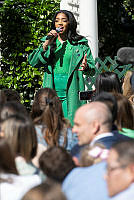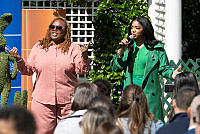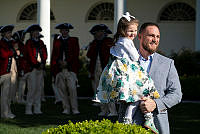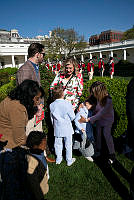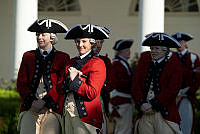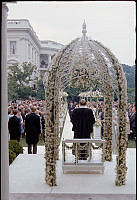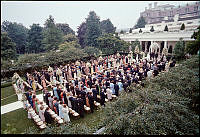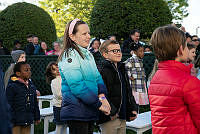Gettysburg and Golf Courses
Ike and the First Presidential Helicopters
Copyright © October 01, 2010 White House Historical Association. All rights reserved under international copyright conventions. No part of this article may be reproduced or utilized in any form or by any means, electronic or mechanical, including photocopying, recording, or by any information storage and retrieval system, without permission in writing from the publisher. Requests for reprint permissions should be addressed to books@whha.org
On July 12, 1957, Dwight D. Eisenhower became the first president in office to employ a helicopter in his transportation service. This event marked a significant development for both the White House and the helicopter industry. In the short term, the helicopter became a key feature of presidential safety in the event of nuclear war. At the same time, Eisenhower’s occasionally contentious decision to utilize helicopters for personal transport signaled an evolving conception of the role of travel in the presidency. His administration embraced a new model for jet-setting diplomacy that relied upon fast and flexible transport in the face of Cold War realities. For the nascent helicopter industry, this development showed to the world that rotary wing technology had become safe and reliable.
While the U.S. military had accepted its first helicopters in 1942, they earned respectability only with the remarkable evacuation of 40,000 wounded during the Korean War.1 By the mid-1950s, helicopter airlines, air taxi services, and tour operators were attempting to establish themselves as viable forms of transport. Scheduled helicopter service had begun in Los Angeles and New York. Commentators suggested that most well-heeled Americans would soon be routinely traveling by helicopter. A reporter noted that Eisenhower was “no whirlybird newcomer; as NATO commander (1951–52), he racked up many copter hours inspecting troops and installations in Western Europe.”2 Some of these flights appear to have been risky. Newsreel footage shows Eisenhower in bad weather in early January 1951 emerging from a Navy HO3S-1 while visiting the cruiser USS Des Moines during maneuvers in the Mediterranean.3 This type of travel was hardly routine.

President Dwight D. Eisenhower.
White House Historical Association/White House CollectionWith increasing confidence in helicopter capabilities in the aftermath of World War II and alarm over the Soviet Union’s acquisition of the atomic bomb in 1949, the Pentagon made provisional plans in the early 1950s for helicopters on standby to transport the president in the case of a national emergency. The exact nature of these plans is still classified, but hints point to details. An air force pilot, Richard Kirkland, recalled being involved in a near evacuation of the president in response to a false alarm on March 15, 1952. Kirkland was posted on standby to Langley Air Force Base in Hampton, Virginia, with an H-5 helicopter and orders to retrieve the chief executive in the event of a national military crisis. On this occasion, he scrambled to lift President Harry S. Truman from the yacht Sequoia, while it was operating near Dahlgren, Virginia, with communications difficulty.4 As Kirkland reached the yacht, he received a recall order, aborting what would have been the first presidential helicopter flight.5
The first vice president to fly by helicopter was Richard M. Nixon, when he visited forward positions in Korea on November 13, 1953, in an H-19. Presidential helicopter transport did not occur until Eisenhower’s second term.6
By 1955, the introduction of hydrogen bombs, jet-powered Soviet strategic bombers, and the impending advent of intercontinental ballistic missiles gave urgency to security experts in the Pentagon and White House pondering how the government might be rapidly relocated in the event of nuclear attack. On June 14, 1955, as part of an annual national civil defense exercise known as Operation Alert, five H-21Cs of the Army’s 509th Helicopter Company evacuated key Pentagon personnel while Eisenhower and White House staffers went on a six-hour automobile trip to a “mountainside retreat.”7
The following November, in another exercise, Air Force helicopters transported fourteen key White House personnel, including Vice President Nixon, on a “plush job” H-19 and the other National Security Council members on three H-21Bs, to a “Shadow Headquarters” at Camp David, where Eisenhower was waiting. At this time, the Secret Service still would “not let the President fly in any kind of single engine aircraft, which the military helicopter is.”8
The president’s arduous Operation Alert evacuation was not lost on White House personnel concerned about Washington’s “heavy traffic and a dearth of arterial highways.”9 Lieutenant Colonel William Draper, Eisenhower’s Air Force aide and chief pilot since his days as NATO supreme commander, won out over Secret Service objections after considerable debate and gained approval to transport the president by helicopter.10 Practical concerns also drove consideration of helicopters. Not surprisingly as the chief backer of the interstate highway system, Eisenhower loathed sitting in traffic and was eager for a return to the efficiencies of travel he enjoyed while acting as NATO supreme commander. One commentator noted that “Ike, himself impatient of transportation delays, has often expressed regrets that other motorists must be inconvenienced by his trips.”11 In March 1957, Eisenhower also received unwanted press attention regarding his motorcade’s speeding much of the way to his Gettysburg farm.12

President Dwight D. Eisenhower departs for Camp David, on July 12, 1957, in the Bell H-13J from the South Lawn.
In the fall of 1956, Draper selected both an appropriate helicopter and a skilled pilot for the president. No word of the plan leaked until February 20, 1957, when the New York Times broke the story, announcing that the Air Force was acquiring helicopters to “take the President from the White House to Washington National Airport,” where Eisenhower’s stable of aircraft was based in a hangar at the Military Air Transport Service terminal. This fleet consisted of the C-121E Super Constellation Columbine III, used for long-range trips, and two diminutive L-26 Aero Commanders acquired in 1955 to allow access to the small Gettysburg Regional Airport.13 The Aero Commanders were an important precursor to allowing helicopter use by the chief executive. Until June 3, 1955, the Secret Service had refused to allow the president to fly on an aircraft with less than four engines.14 However, Eisenhower was perfectly comfortable in light aircraft, having earned his pilot’s license while stationed in the Philippines in 1939, later becoming the first president to have that distinction. This situation had undoubtedly made it far easier for Draper to prevail over the Secret Service.
Draper selected a pair of Bell H-13Js—modest helicopters by today’s standards. The choice was remarkable as they were not standard military equipment, could accommodate only two passengers with any real degree of comfort, had an effective range of a mere 150 miles, and were somewhat slow, with a top speed of around 100 miles per hour. As these were a single pilot aircraft, unlike the larger military models, they must have generated some concerns over the potential incapacitation of the pilot. Essentially a civilian off-the-shelf model that was an evolution of the bubble-topped Model 47s of Korean War fame, Bell marketed the Ranger (its civilian designation) principally for VIP travel. Later, it gained fame as the helicopter flown by Elvis Presley in the 1966 Paramount film Paradise, Hawaiian Style.
The Ranger did have some significant advantages. Its base purchase price of $40,000 and low operating costs made it one of the most economical helicopters in its class, but most important, it had an outstanding safety record and was the most reliable design available. As part of the Model 47 series (the first civil certificated helicopter in the world), it had a decade of operational use behind its design. The official White House statement on the H-13J noted that “this type helicopter has over 2½ million flight hours under all conditions and is considered by experts to be the safest and most dependable helicopter in its class.”15 Bell’s trademark “teetering” rotor system accounted for much of its sterling safety record. The much larger and more capable Sikorsky and Vertol designs employed complex articulated rotor systems incorporating hinges and other components with additional points of failure and increased maintenance concerns. Their World War II–era radial engines were more prone to fires and other failures.
The Ranger did have some significant advantages. Its base purchase price of $40,000 and low operating costs made it one of the most economical helicopters in its class, but most important, it had an outstanding safety record...
Aviation Week provided an alternative explanation for why the small helicopter was selected: “According to White House sources, the Bell was chosen over larger types primarily because they were considered too noisy.” 16 This asset seems insignificant relative to safety concerns, especially as the presidential H-13Js required additional soundproofing. 17 Nonetheless, Draper’s decision not to employ one of the larger military models from the outset is remarkable and a statement on the general lack of confidence in the state of helicopter designs at the time.
The H-13J’s interior featured upgraded upholstery but was plain for the august presidential role it served. The most obvious upgrade was the addition of a dark blue tinted Plexiglas bubble in place of the standard transparent installation to reduce its tendency to act like a magnifying glass in the sun. Otherwise, the only substantive improvements over standard models were military radios and a rotor-brake to reduce the shutdown time and allow the president a more rapid exit (a helicopter rotor is most dangerous to pedestrians as it slows because it begins to droop). Nonetheless, these features increased the cost by 50 percent. Though later described as being capable of night flying, the helicopters lacked attitude flight instruments and would have been hazardous to fly in darkness or low visibility conditions.
The two helicopters with spares came to a controversial purchase price (in 1957 dollars) of $201,000, with an estimated hourly operating cost of $33.63 (less than 10 percent that of the flagship Columbine III, which was not criticized).18 The individual purchase price for each upgraded H-13J was $60,000, which was $5,000 less than Eisenhower’s Cadillacs and $15,000 less than the Aero Commanders.19 Eisenhower was not the first national leader to have a Ranger: Colombian President Gustavo Rojas Pinilla used one regularly, though no other head of state of a major power had yet adopted this mode of transport.20

The upholstery was upgraded for the presidential helicopter but was not luxurious as some initial reports insisted. The H-13J could seat only two passengers and was not as comfortable as it would be in later presidential helicopters, but the president never had a better view.
In selecting the president’s helicopter pilot, Draper had combed Air Force records for pilots with more than 2,000 hours of accident-free rotary wing flight time. He brought ten candidates to Washington for interviews and ultimately selected 33-year-old Major Joseph E. Barrett. Barrett was quite possibly the most capable helicopter pilot in the air force at the time. A B-17 pilot during World War II, he was shot down and captured on only his second mission—the disastrous Schweinfurt raid of 1943. After his repatriation, he saw helicopters as the key to his advancement and served as operations officer of the helicopter section of the first special operations helicopter unit to go into combat. He received a Silver Star in Korea for flying 70 miles behind enemy lines to retrieve a downed marine pilot under heavy fire. Subsequently, he authored the Air Force helicopter operations manual. Also selected were Captains Lawrence Cummings and John Wilkinson, who respectively served as the first and second alternates for presidential flights.21
Barrett looked closely at the routes he planned to fly, driving them first and carefully noting possible emergency landing fields. As the most routine flight was likely to be the shuttle service between the White House and National Airport, Barrett spent considerable energy in analyzing the flight path to minimize the time over open water and to stay out of the approach path of aircraft landing at the airport. This appears to have even included anchoring a buoy in the Potomac to mark the crossing point and to provide a “point of no return” marker for indicating which side of the river could be reached in the event of engine failure. He told one reporter that he and Captain Cummings averaged “50 power-off landings a month” in training.22
The presidential helicopter program was slow to gain the attention of the press, but it finally did so in an unwelcome manner. The Wall Street Journal began the surprisingly strident criticism of what many commentators would initially perceive as a luxury for a president who had struggled to build an image of fiscal conservatism. In a sarcastic tone, an article entitled “The Helicopter Dollar” noted that the helicopters might save the president only 6 minutes, as flights to National Airport took 3–4 minutes while driving took 10–20 minutes, then went on to state, “It is nice too that the President can save time even if he is having trouble saving the taxpayers’ money.”23
Press Secretary James Hagerty subsequently expanded the options for the helicopter, suggesting that the helicopters could be used for direct flights to Eisenhower’s beloved Gettysburg farm. Unfortunately, media coverage took another turn on March 4, 1957, when Vern Haugland, writing for the Associated Press, stated that “President Eisenhower is going to use helicopters to fly between the White House and Burning Tree Country Club [in Bethesda, Maryland, less than 10 air miles from the White House], thus avoiding any street traffic.” Haugland suggested that this information had been deliberately withheld, noting that in earlier reports “nothing was said of any plans for commuting to the golf course.” He also reported that a much larger and complex Sikorsky S-58 helicopter with a comfortable seating capacity of a dozen was under consideration (untrue at the time, but a reality that came to pass six months later).24 Hagerty immediately refuted Haugland’s points, but seemed to contradict himself by announcing, “The only run now being planned is from the White House to the Military Air Transport Service terminal at the airport.”25

President Dwight D. Eisenhower's pilots Major Joseph E. Barrett and Captain Lawrence Cummings flying Bell H-13Js in formation over the Texas countryside, February 1957.
What had provoked such negative press response to the helicopters? While Eisenhower had eliminated much of the traditional transport—yachts and railcars—of his recent predecessors, with considerable fanfare over the savings generated, he also significantly expanded the limousine fleet of the White House (including a “bubble-top” Lincoln of his own design) and formalized presidential air travel under William Draper. In his stellar military career, General Eisenhower had become accustomed to traveling widely for general staff meetings, inspections, and diplomatic tête-à-têtes, a tradition he carried into the presidency. U.S. News and World Report remarked, “Mr. Eisenhower is far ahead of any previous President when it comes to conveniences and conveyances. . . . Now with the addition of two helicopters to his transportation armada, the President will have a vehicle for every occasion.” The magazine also reprinted a Fort Wayne News Sentinel cartoon depicting Eisenhower in the helicopter with his golf clubs and a caption, “Ike’s Answer for Washington Traffic.”26
On March 27, 1957, criticism of the helicopters came to a head. Herb Block ran an editorial cartoon in the Washington Post entitled “The Helicopter Era” that depicted a giddy and aloof Ike flying his helicopter above riotous crowds fighting over civil rights, trade, education, immigration, foreign aid, and the budget. That afternoon, Eisenhower held a press conference to promote the latest budget. William McGaffin of the Chicago Daily News asked: “Sir, do you feel there are any economies that you can make in the executive branch of government to help cut government spending? For instance, would you be willing to do without that pair of helicopters that have been proposed for getting you out to the golf course a little faster than you can make it in a car?”27 A Time magazine correspondent reported, “At the question Eisenhower showed more anger than most Washington correspondents have ever seen him betray. His face blanched and then a flush of red spread upward from his neck. After a moment of dead silence he glared, and his words came like smallarms fire. ‘Well, I don’t think much of the question, because no helicopters have been procured for me to go to a golf course.’”28 The outburst provoked considerable commentary on the unsettled state of the president. Eisenhower’s political opponents also took the opportunity to get their jibes in over the topic. On April Fools Day, Alabama Governor James Folsom remarked sarcastically that all of his state’s National Guard helicopters were available to the president for “golfing, fishing, hunting or whatever else he might need them for. . . . [His] health, time and welfare are worth more to the people of Alabama than all the helicopters in the world.”29
On April 6, 1957, Hagerty revealed that the Air Force had taken delivery of the H-13Js at Bell’s Fort Worth plant and they were to undergo a month of testing at Olmsted Air Force Base not far from Camp David and the Eisenhower farm so that operating procedures could be established. This statement did not dissuade continuing “highly speculative reports about their plush appointments” by some reporters. However, Hagerty changed tack and announced that the helicopter was to be essential in evacuating the president in case of nuclear attack.30 Four days later, he reported that the helicopter would play a central role in the next Operation Alert, scheduled for mid-July, by whisking the president away to a “secret hide-away.”31 The delay in revealing the national security concerns driving the acquisition of the helicopters is puzzling.
Hagerty also categorically denied that the Bell helicopters were being fitted with “extra plush interiors” and remarked, “I would think [the helicopters] would not be used to go to Burning Tree at any time.”32 This assertion was enough to change the tide of opinion. The editors of the Toledo Times regretted “the fuss that may make it difficult for [Eisenhower] to use either of the helicopters for quick trips on all desired errands. . . .[We] consider the President’s time valuable enough to be saved, whenever possible, in any way possible.”33 The Providence Journal’s editorial was even more outspoken, arguing that the helicopters were in keeping with presidential tradition and that their cost was but a fraction of the White House yacht Williamsburg, which Eisenhower had placed in mothballs shortly after entering office, with an annual savings of nearly $600,000.34

Barrett and Cummings review procedures for the H-13J while training at the Bell plant in Fort Worth, Texas.
On May 8, the H-13Js, with Barrett and Cummings at the controls, made their debut in Washington during a trial run for Operation Alert by landing on the Ellipse. By today’s security-conscious standards, coverage of the helicopter’s arrival procedures was remarkably forthright: “The President’s helicopters will enter [the prohibited airspace] by flying up the river’s Georgetown Channel over the District entrance of the Memorial Bridge and then will weave over open areas until the pilots put down on the White House lawn. . . .Flights will be made at altitudes ‘under 500 feet.’”35 In addition to National Airport’s Military Air Transport Center, the helicopters were cleared for operations from Andrews and Bolling Air Force Bases, Anacostia Naval Air Station, and Fort Belvoir.
On May 31, Barrett landed a helicopter for the first time on the South Lawn of the White House, though this was not the first time a rotary wing aircraft had landed there.36 Twenty-six years earlier, James Ray touched down on the grounds in a Pitcairn-Cierva PCA-2 autogiro as part of an award ceremony. In 1911, Harry Atwood had landed there in his Wright Model B airplane as part of a similar event.
On July 11, Hagerty confirmed that the Operation Alert drill the next day would indeed feature the first presidential helicopter flight, but that the helicopter itself was technically not part of the evacuation—presumably to allow a leisurely photo op rather than a frantic dash for safety, which might have looked less than dignified.37 At 2:08 p.m. on July 12 (after the photo op and two hours after the civil defense sirens sounded), Major Barrett lifted off in H-13J serial number 57-2729 with Eisenhower sitting in the right rear and James Rowley, chief of the White House Secret Service detail, sitting to his left.38 Cummings flew 57-2828 in trail with Major General Howard Snyder, Ike’s personal physician and a second Secret Service agent. Barrett then proceeded to their undisclosed evacuation site (Camp David) at an altitude of 500–700 feet above the terrain.39
In addition to the H-13Js, six larger helicopters descended on the Ellipse to airlift twenty key staffers and pool reporters. These included tandem-rotor Vertol H-21s of the Air Force and Army, as well as a Marine Corps HUS-1 and an obsolescent Air Force H-19 (probably Nixon’s “plush job”). Naval personnel created an ad hoc air traffic control center on the South Lawn to marshal the arriving whirlybirds. Virgil Olson, who later became the first official Marine Corps presidential helicopter pilot, recalled that the other larger and faster helicopters supporting Operation Alert, which had departed after the H-13J, “arrived several minutes before the small [and slower] Bell. When the president arrived, he was sweating from an uncomfortable ride and annoyed to find us on the ground, with the engines of our helicopter already off and cooled down.”40 Olson cites the experience as explaining why Eisenhower abandoned the diminutive Bells after he returned from Gettysburg.

Marine One arrives at the White House. These are Sikorsky VH-3Ds.
Official White House Photo by Lawrence JacksonAfter spending the night at Camp David, Eisenhower drove with family members to Gettysburg, but he flew back to Washington in the H-13J on Monday morning with another stopover at the Camp David “command post.”41 Unfortunately for the White House, the exercise did not entirely remove the controversy surrounding the helicopters. At a press conference four days after Eisenhower’s return, Peter Kumpa of the Baltimore Sun asked the beleaguered Hagerty if Eisenhower’s Aero Commanders and Rangers were not “a symbol of needless luxury.”42
The next presidential helicopter flight occurred on September 7, 1957. Eisenhower, concerned about the racial tensions in Little Rock, arranged for a Marine Sikorsky HUS-1 on an ad hoc basis to ferry him from his Rhode Island vacation home to Naval Air Station Quonset Point so he could fly back to Washington on Columbine III and then return to his vacation the next day. He saved 33 of the 40 minutes required for the yacht trip across Narragansett Bay. With enough accommodation to seat twelve passengers comfortably and without the sauna-like heating of the Bell’s bubble, Eisenhower clearly preferred the Sikorsky and never flew in the H-13Js again.
Draper responded with a considerable restructuring of the presidential helicopter arrangements. No longer would the Air Force be the sole source of air transportation, as the service did not operate the large Sikorsky-type Eisenhower now preferred. During the fall of 1957, Draper worked with the Army and Marine Corps to establish a safe, comfortable, and secure helicopter transport program that went into effect in the beginning of 1958. To avoid the appearance of favoritism, Eisenhower decided to alternate flights between each of the services, which provided their own pilots and airframes. The Marine Corps’ helicopter experimental squadron, HMX-1, based in Quantico, Virginia, operated Sikorsky HUS-1s under the command of Lieutenant Colonel Virgil Olson, while the Army established a new organization, the Executive Flight Detachment, based at Fort Belvoir, Virginia, with Major William Howell as the chief pilot and operating the army version of the HUS-1, the H-34C.43 These aircraft featured considerably upgraded interiors with soundproofing and secure communications equipment. Subsequent improvements included the addition of pop-out floats on the wheels in case of an emergency water landing, a crude air-conditioning system, and white painted roofs to aid in cooling—a tradition that endures to the present day. These aircraft cost about six times as much as the H-13Js, yet did not raise the alarm of the press, nor did the announcement that the White House was acquiring three VC-137 jets at $5 million apiece. What had changed? Sputnik brought the stakes of the Cold War home as never before. Worrying about the economies of presidential transport ceased to be a national concern.
For the remainder of his term, Eisenhower flew on the Sikorskys with increasing frequency and began to introduce other heads of state, including Nikita Khrushchev, to the advantages of helicopter transportation. The helicopters also followed him on visits across five continents. As he was giving John F. Kennedy his introductory tour to the White House, Eisenhower showed the president-elect a button on the desk in the Oval Office and said, “If you punch this button, a helicopter will be on the South Lawn in five minutes.” He pushed the button, and to Kennedy’s amusement, the helicopter was indeed there in five minutes.44 Shortly after entering office, President Kennedy upgraded the fleet to the turbine-powered Sikorsky S-61s that are the immediate forerunners of the helicopters now in service. In only five years, presidential helicopter transport had matured from small machines seen as unnecessary luxuries to capable flying offices that have come to symbolize the authority of the presidency. Perhaps the best indication of how fast opinions had changed was a helicopter trip made on June 9, 1960, without negative press commentary. The departure point was the Burning Tree Country Club.45

President Dwight D. Eisenhower arrives via U.S. Marine Corps helicopter on board the U.S. Navy heavy cruiser USS Des Moines, December 15, 1959.
Official U.S. Navy Photograph, from the collections of the Naval History and Heritage Command













